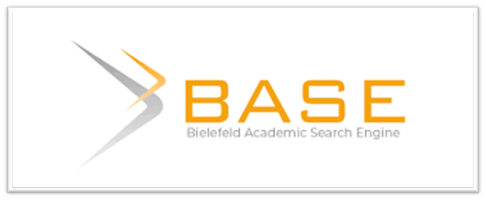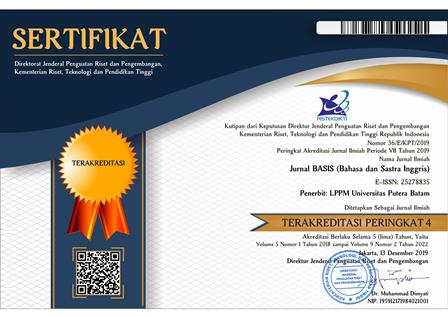BROCA APHASIA LANGUAGE IMPAIRMENT IN SARAH SCOTT’S YOUTUBE CHANNEL
DOI:
https://doi.org/10.33884/basisupb.v8i2.4462Keywords:
aphasia, Broca's aphasia, language impairmentAbstract
Aphasia is a language disorder caused by brain damage and makes the patient lose or impair language skills. One of the diseases which often cause people to experience aphasia is stroke. In this study, the researchers observed the characteristics of language impairment of Sarah Scott. She’s a young woman suffering from Broca's aphasia after stroke. This study employed a qualitative descriptive method on the utterances she produced in SymphUK YouTube channel as the data source. In collecting the data, the researchers watched and transcribed the utterances containing the language disorder. The analysis used the theory of Hallowel (2017) on the characteristics of Broca's aphasia and Ardila (2014) about the linguistics defects in aphasia. The finding shows that the most dominant characteristic was dysnomia, literal (phonemic) paraphasia, and agrammatism among twenty-six utterances. Then, the other characteristics that also appeared were disfluency, repetition, and telegraphic speech. Furthermore, the levels of language-impaired in Sarah Scott were morphemic, morphosyntactic, and phonetic. Thus, the following study should cover more subjects with different age, gender, and language to see whether more variation of characteristics of Broca's aphasia appears in different contexts.
References
Ardila, A. (2013). A New Classification of Aphasias. Departments of Communication Science Disorder.
Ardila, A. (2014). Aphasia Handbook. Florida: Florida International University.
Ardila, A., & Benson. (1996). Aphasia: A clinical perspective. New York: Oxford University Press.
Azad, O. (2020). Lexical Ambiguity Processing in Persian-speaking Patients with Broca and Wernicke Aphasia. Modern Rehabilitation, 39.
Beverley, H. (1998). An Introduction to Qualitative Research. Nottingham: The Trent Focus Group.
Bodgan, R. C., & Biklen, S. K. (1982). Qualitative Research For Education (An Introduction to Theory and Methods). Syracuse: Nancy Forsyth.
Code, C. (2019). The Cambridge Handbook of Psychology, Health and Medicine (pp.428). Cambridge: Cambridge University Press.
Ellis, C., Phillips, R., Hill, T., & Briley, P. M. (2019, August). Social network structure in young stroke survivors with aphasia: A case series report. In Seminars in speech and language (Vol. 40, No. 05, pp. 359-369). Thieme Medical Publishers.
Hallowell, B. (2017). Aphasia and Other Acquired Neurogenic Language Disorder : a guide for clinical excellence . San Diego: Plural Publishing.
Heal, B. (2019). Word Error and Word Frequency Correlation in Broca's aphasia. Speech Pathology and Audiology Commons .
Indah, R. N. (2011). Gangguan Berbahasa. Malang: UIN Press.
Indah, R. N., & Abdurrahman. (2008). Psikolinguistik: Konsep & Isu Umum . Malang: UIN Press.
Jordan, L., & Keiser, W. (1996). Aphasia- A Social Approach. Canada: Chapman & Hall.
Nichcy, N. D. (2011). Speech and Language impairment. Disability Fact Sheet, 3.
Project, I. C. (2021, January 21). Retrieved from International Communication Project: https://internationalcommunicationproject.com/profile/an-18-year-old-with-aphasia-sarahs-story/
Rahmi, E., & Arianto, T. (2019). Schizophrenia Symptoms Acute in Teddy Alias Andrew in The “Shutter Island” Novel by Dennis Lehane. Jurnal Basis, 6(2), 225-236. http://ejournal.upbatam.ac.id/index.php/basis/article/view/1422
Reily, J. (2014). Language Disorder. Encyclopedia of Theory in Psychology, 3.
Septianto, R. D. (2020). A Case of Language Disorder on Aphasia and Its Phonological Error Found Within Edwyn Collins Utterances as A Main Character in The Possibilities Are Endless Movie. Surakarta: Unpublished Undergraduate Thesis.
Souchon, N. M., Krüger, E., Eccles, R., & Pillay, B. S. (2020). Perspectives of working-age adults with aphasia regarding social participation. African Journal of Disability, 9.
Syarifah, W. H. (2020). Broca's aphasia Word Production on My Beautiful Broken Brain Movie. Malang: Unpublished Undergraduate Thesis.
Withaker, H. A. (2007). Language Disorder: Aphasia. Encyclopedia of Language and Linguistics, 10.
Yulia, H., Syarif, H., & Marlina, L. (2018). The Syntactical Analysis of The Influence of Speech Therapy to Post Stroke Patients With Broca's aphasia Speech Ability. E-Journal of English Language & Literature, 422-431.
Downloads
Published
Issue
Section
License













 JURNAL BASIS (BAHASA DAN SASTRA INGGRIS)
JURNAL BASIS (BAHASA DAN SASTRA INGGRIS)
